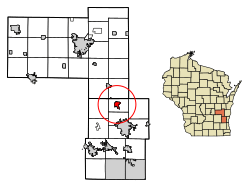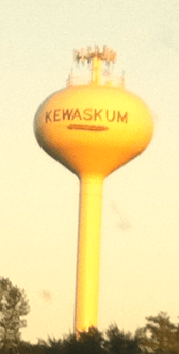Kewaskum, Wisconsin facts for kids
Quick facts for kids
Kewaskum, Wisconsin
|
|
|---|---|

Intersection of US 45 and WIS 28 in downtown Kewaskum
|
|

Location of Kewaskum in Fond du Lac County (top) and Washington County (bottom), Wisconsin.
|
|
| Country | |
| State | |
| Counties | Washington & Fond du Lac |
| Settled | 1852 |
| Incorporated | 1895 |
| Area | |
| • Total | 2.35 sq mi (6.10 km2) |
| • Land | 2.35 sq mi (6.10 km2) |
| • Water | 0.00 sq mi (0.00 km2) |
| Elevation | 935 ft (285 m) |
| Population
(2020)
|
|
| • Total | 4,309 |
| • Density | 1,833.6/sq mi (699.38/km2) |
| Time zone | UTC-6 (Central (CST)) |
| • Summer (DST) | UTC-5 (CDT) |
| Area code(s) | 262 |
| FIPS code | 55-39325 |
| GNIS feature ID | 1583474 |
Kewaskum is a village in Wisconsin, United States. It is located in both Washington and Fond du Lac counties. In 2020, about 4,309 people lived here. Most of the village is surrounded by the Town of Kewaskum.
Contents
Understanding the Name: Kewaskum's Origin
Kewaskum was a respected leader of the Potawatomi Native Americans. His group lived in Washington County during the 1840s. He was known for being friendly with the early settlers.
In 1849, the settlers named the Town of Kewaskum in his honor. Later, the village also took his name. In the Potawatomi language, "Kewaskum" means "turning back on his tracks" or "retracing his steps."
Exploring Kewaskum's Past: A Village History
Early Native American Life
In the early 1800s, the Kewaskum area was home to the Potawatomi people. They gave up their land to the United States government in 1833. This agreement asked them to leave Wisconsin by 1838.
Many Potawatomi moved west of the Mississippi River. However, some chose to stay in Wisconsin. These groups were called "strolling Potawatomi." They often lived on their traditional lands, which were now owned by new settlers.
One group was led by Chief Kewaskum. He had a camp near Pike Lake. Chief Kewaskum was friendly with the white settlers who arrived in the 1840s. Even after his death, some Potawatomi lived in Washington County. Many later joined the Forest County Potawatomi Community in northern Wisconsin.
First Settlers and Community Growth
The first settlers in the area were the Barnes family. They arrived in 1844 and started farming. In 1847, the area became the Town of North Bend. The first post office was also set up then.
In 1849, residents changed the name to the "Town of Kewaskum." This helped to tell it apart from the nearby town of West Bend.
From Myer's Mill to a Prosperous Village
The village of Kewaskum began in 1852. J. H. Myer settled by the Milwaukee River. He built a sawmill and a gristmill. The settlement was first called "Myer's Mill." Later, it was known as "Kewaskum Center."
It quickly became a market town for local farmers. It had a general store and a blacksmith shop. Religious services were first held in homes. Then, churches were built in the 1860s.
In 1873, the Chicago and North Western Railway built a train line. It connected Milwaukee to Fond du Lac, with a stop in Kewaskum. This train connection helped the local economy grow. New businesses like hotels and stores opened. The Village of Kewaskum officially became a village in 1895.
Industry and Expansion in the 20th Century
Kewaskum's economy was mostly farming in the early 1900s. But it slowly became more industrial. In 1919, Adolph L. Rosenheimer started the Kewaskum Aluminum Company. It made aluminum cookware.
During World War II, the company made items for the military. In 1951, it was renamed Regal Ware. This company grew into a big international business. It made high-end cookware.
The village's population grew after World War II. New homes and businesses were built. Kewaskum expanded its borders many times. It even added land from Fond du Lac County in 1963.
Kewaskum's Location and Layout
The main north-south road in Kewaskum is U.S. Route 45. The main east-west road is Wisconsin Highway 28. Kewaskum is part of the 262 Area Code in southeastern Wisconsin.
The village covers about 2.45 square miles (6.10 square kilometers). All of this area is land.
People and Population: A Look at Kewaskum's Residents
| Historical population | |||
|---|---|---|---|
| Census | Pop. | %± | |
| 1880 | 471 | — | |
| 1890 | 557 | 18.3% | |
| 1900 | 679 | 21.9% | |
| 1910 | 625 | −8.0% | |
| 1920 | 707 | 13.1% | |
| 1930 | 799 | 13.0% | |
| 1940 | 880 | 10.1% | |
| 1950 | 1,183 | 34.4% | |
| 1960 | 1,572 | 32.9% | |
| 1970 | 1,926 | 22.5% | |
| 1980 | 2,394 | 24.3% | |
| 1990 | 2,515 | 5.1% | |
| 2000 | 3,274 | 30.2% | |
| 2010 | 4,004 | 22.3% | |
| 2020 | 4,309 | 7.6% | |
| U.S. Decennial Census | |||
Population in 2020
In 2020, Kewaskum had 4,309 people. There were 1,762 households. The village had about 1,833 people per square mile.
Most residents, 92.6%, were White. About 1.2% were Black or African American. Around 0.8% were Asian. About 1.0% were from other races. And 4.1% were from two or more races. About 3.1% of the population was Hispanic or Latino.
Population in 2010
In 2010, 4,004 people lived in the village. There were 1,581 households. The population density was about 1,634 people per square mile.
About 96.0% of residents were White. About 0.5% were African American. About 0.3% were Native American. About 0.5% were Asian. Around 1.2% were from other races. About 1.3% were from two or more races. About 2.9% of the population was Hispanic or Latino.
The average age in the village was 36.8 years. About 25.4% of residents were under 18 years old. About 12.7% were 65 years or older.
Famous Faces: Notable People from Kewaskum
- Ty Bodden, a Wisconsin State Representative, used to live here.
- Louis D. Guth, a Wisconsin State Representative and businessman, lived in Kewaskum.
- Kenneth William Haebig, a Wisconsin State Representative and lawyer, lived in Kewaskum.
- Einar H. Ingman Jr., a Medal of Honor recipient, lived in Kewaskum.
- Jesse Kremer, a Wisconsin State Representative, lived in Kewaskum.
- Timothy Ramthun, a Wisconsin State Representative, lived in Kewaskum.
- Jordan Stolz, an American world champion speedskater, lives in the village.
- Glenway Wescott, a famous author, was born in Kewaskum.
See also
 In Spanish: Kewaskum para niños
In Spanish: Kewaskum para niños


